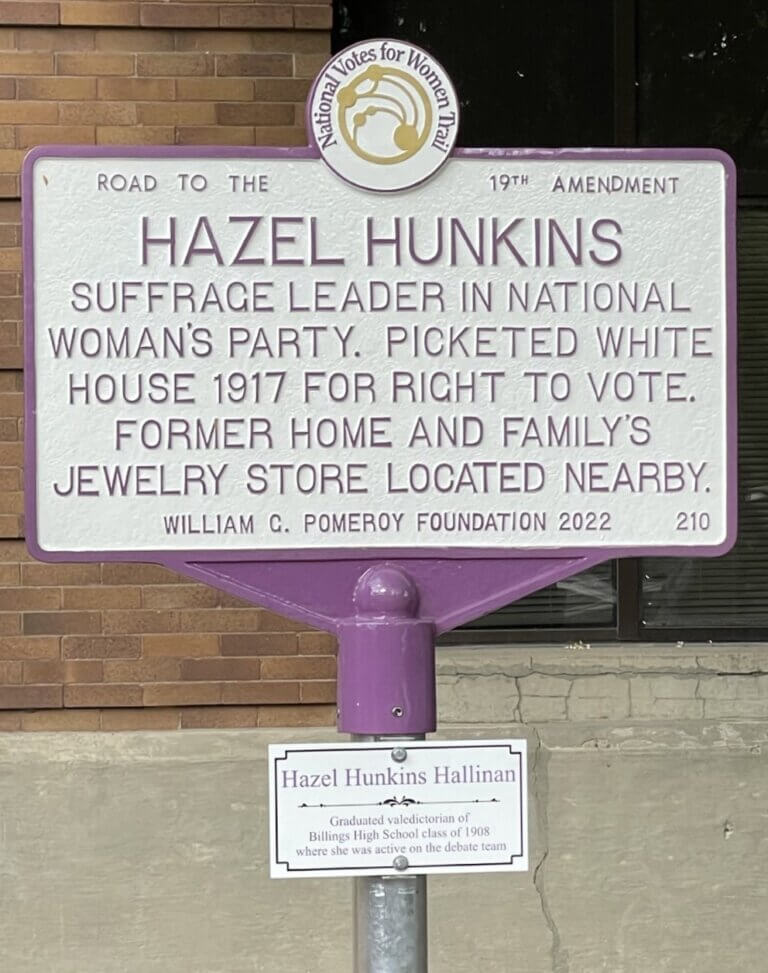HAZEL HUNKINS
- Program
- Subject
- Location
- Lat/Long
- Grant Recipient
-
National Votes for Women Trail
-
House, People, Site
- 415 N 30th St #111, Billings, MT 59101, USA
- 45.784182, -108.511269
-
National Collaborative for Women's History Sites
HAZEL HUNKINS
Inscription
HAZEL HUNKINSSUFFRAGE LEADER IN NATIONAL
WOMAN'S PARTY. PICKETED WHITE
HOUSE 1917 FOR RIGHT TO VOTE.
FORMER HOME AND FAMILY'S
JEWELRY STORE LOCATED NEARBY.
WILLIAM G. POMEROY FOUNDATION 2022
Suffragist Hazel Hunkins (Hallinan) (1890-1982) of Billings, Montana was a leader in the National Woman’s Party (NWP). The NWP was established during the final years of the women’s suffrage movement, with the sole aim being the immediate passage of an amendment to the United States Constitution that would secure women’s right to vote. Hunkins was a national organizer for the NWP and worked in the Business Department of the NWP’s official weekly publication, The Suffragist.
The NWP used controversial campaign tactics, including dramatic public demonstrations sometimes resulting in the arrests of suffragists. These tactics were considered controversial in part due to the country being involved in World War I at the time. During the war, the NWP continued to put pressure on President Woodrow Wilson and Congress to pass a women’s suffrage amendment. In 1917, Hunkins was one of the “Silent Sentinels” who picketed in front of the main gates of the White House in support of women’s suffrage. She was arrested and charged with disorderly assembly in July of that year for her part in the demonstrations.
In a July 20, 1917 edition of the Billings Gazette, Hunkins explained why the suffragists were picketing the White House, even though the country was at war:
“For 60 years women have been figuratively standing at the doors of congress patiently waiting for legislative relief. You naturally would expect that they have gotten tired of this plan of campaign and they did get tired. Now we are demanding action. … Reforms of every other kind have been set aside and buried under the plea of war necessities but instead of allowing suffrage to be smothered we are taking advantage of the war situation to point out that if this war is for democracy; if we are to send our soldiers 3,000 miles into the trenches of a foreign land to fight for democracy, it would not be amiss to have democracy extended at home.”
Hunkins was arrested again in 1918 for her part in a suffrage demonstration in Lafayette Park opposite the White House. The tireless efforts of suffragists like Hunkins finally paid off in June 1919, when Congress passed the Nineteenth Amendment that states the right to vote cannot be denied on account of sex. By August 1920, 36 states had ratified the amendment, securing women’s right to vote across the country.
Hunkins grew up in Billings, Montana having graduated valedictorian of the 1908 class of Billings High. During her years of suffrage activism, Hunkins would travel back to Billings, where her family owned a jewelry store. From 1907 to 1919, the store was located in the Babcock Theater Building in Billings.


